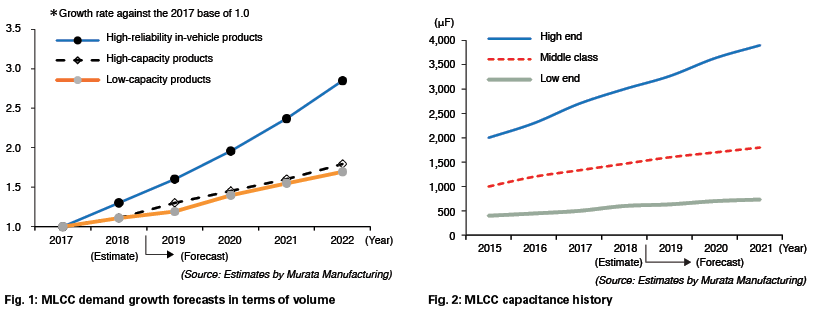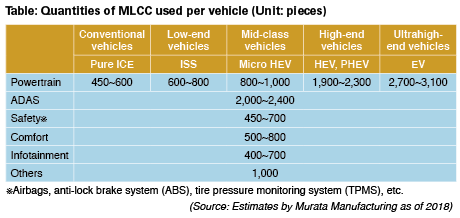

MLCC Manufacturers Grapple with Huge Demand-Supply Gap
T
he demand-supply balance for multilayer ceramic capacitors (MLCCs) continue to remain tight, reflecting strong demand for smartphones and other communications devices and sharp increase in demand for automotive electronics.
Market leader Murata Manufacturing Co., Ltd. produces 1 trillion units of MLCCs a year and secures 40 percent share of the global MLCC market. As of the end of Sept. 2018, the company had unfilled orders worth ¥195.6 billion, ¥47 billion more than the record high at the end of Mar. 2018. Robust demand for the company's in-vehicle MLCCs continued in October and November, and the higher demand for the entire MLCCs remains unchanged.
In 2019, investments in fifth-generation (5G) next-generation communications infrastructure will begin on full scale, and new demand for MLCCs for communications devices for Internet of Things (IoT) is expected to take off. MLCC manufacturers actively infuse additional investments to increase production and promote downsizing of products to increase supply capacities. Yet, demand still surpasses supply, and "the sense of tightness will continue throughout 2019," notes Satoshi Sonoda, Executive Vice President, Head of Global Sales & Marketing Unit, Director of Tokyo Branch, Murata Manufacturing Co., Ltd.
Main Demand Driver
MLCCs for in-vehicle use continue to be the primary demand driver. The number of MLCCs incorporated in vehicles has increased resulting from the progress in electrification, increase in the adoption rate of advanced driver-assistance systems (ADAS), popularization of electric vehicles (EVs), and integration of electronic control units (ECUs). Furthermore, with the addition of needs for downsizing and larger capacities, the demand for MLCCs has increased sharply. The number of MLCCs per vehicle has increased to 3,000 to 8,000 units. In EVs with the latest specifications, more than 10,000 MLCCs are used per vehicle.


In the future, as the level of autonomous driving advances, fast processing of data from various sensors will result in higher power consumption, thus accelerating greater MLCC capacity and a larger number of MLCCs used per vehicle. The industry views that about 2,000 units of MLCCs will be used in level 1, about 3,000 units in level 2, about 4,000 units in level 3, and more than 4,000 units in level 4.
Murata Manufacturing positions the automotive electronics market as the new foundation market, and responds to demand both for the in-car platform for vehicles themselves, including electrification, ADAS, and autonomous driving, and the out-car platform, including vehicle-to-vehicle (V2V) and vehicle-to-infrastructure (V2I) systems. Murata can reliably supply the technologies and volume required for automotive applications, including guaranteed high temperature, countermeasures against risk of short circuit, long-term reliability, and high voltage support, "as it aims to continue to be the MLCC manufacturer chosen by customers based on technologies and reliability it has nurtured," notes Tsuneo Murata, Chairman of the Board and President of Murata Manufacturing.

 English
English Japanese
Japanese